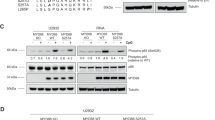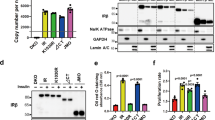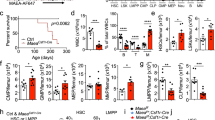Abstract
Anaplastic lymphoma kinase (ALK) is a transmembrane receptor tyrosine kinase in the insulin receptor superfamily. We recently demonstrated that the growth factors pleiotrophin (PTN) and midkine (MK) are ligands for ALK and that upon ALK activation, insulin receptor substrate-1 (IRS-1) and other substrates are phosphorylated. Here, the role of IRS-1 in ligand-mediated ALK signaling is investigated in interleukin-3 (IL-3)-dependent 32D murine myeloid cells. These cells do not express ALK and IRS family members, and do not respond to exogenously added PTN or MK. We show that expression of ALK plus IRS-1 renders these cells independent of IL-3 owing to the activation of ALK by endogenous MK. Mutational analysis reveals that this transformed phenotype of 32D cells requires kinase-active ALK as well as the interaction of ALK with IRS-1. Furthermore, 32D/IRS-1/ALK cells display an enhanced activation of mitogen-activated protein kinase and PI3-kinase pathways, and a selective transcriptional activation of nuclear factor (NF)-κB. Small interfering RNA-mediated knockdown of the endogenous MK or p65/NF-κB revealed that both these are rate limiting for the transformed phenotype induced by ALK plus IRS-1. We conclude that the recruitment of IRS-1 to activated ALK and the activation of NF-κB are essential for the autocrine growth and survival signaling of MK.
This is a preview of subscription content, access via your institution
Access options
Subscribe to this journal
Receive 50 print issues and online access
$259.00 per year
only $5.18 per issue
Buy this article
- Purchase on Springer Link
- Instant access to full article PDF
Prices may be subject to local taxes which are calculated during checkout







Similar content being viewed by others
References
Bai RY, Dieter P, Peschel C, Morris SW, Duyster J . (1998). Nucleophosmin-anaplastic lymphoma kinase of large-cell anaplastic lymphoma is a constitutively active tyrosine kinase that utilizes phospholipase C-gamma to mediate its mitogenicity. Mol Cell Biol 18: 6951–6961.
Ballinger MD, Shyamala V, Forrest LD, Deuter-Reinhard M, Doyle LV, Wang JX et al (1999). Semirational design of a potent, artificial agonist of fibroblast growth factor receptors. Nat Biotechnol 17: 1199–1204.
Baserga R . (1999). The IGF-I receptor in cancer research. Exp Cell Res 253: 1–6.
Baserga R . (2000a). The contradictions of the insulin-like growth factor 1 receptor. Oncogene 19: 5574–5581.
Baserga R . (2000b). Insulin-like growth factor I receptor signalling in prostate cancer cells. Growth Horm IGF Res 10 (Suppl A): S43–S44.
Bowden ET, Stoica GE, Wellstein A . (2002). Anti-apoptotic signaling of pleiotrophin through its receptor, anaplastic lymphoma kinase. J Biol Chem 277: 35862–35868.
Burks DJ, White MF . (2001). IRS proteins and beta-cell function. Diabetes 50 (Suppl 1): S140–S145.
Chang Q, Li Y, White MF, Fletcher JA, Xiao S . (2002). Constitutive activation of insulin receptor substrate 1 is a frequent event in human tumors: therapeutic implications. Cancer Res 62: 6035–6038.
Colleoni GW, Bridge JA, Garicochea B, Liu J, Filippa DA, Ladanyi M . (2000). ATIC-ALK: a novel variant ALK gene fusion in anaplastic large cell lymphoma resulting from the recurrent cryptic chromosomal inversion, inv(2)(p23q35). Am J Pathol 156: 781–789.
Cristofanelli B, Valentinis B, Soddu S, Rizzo MG, Marchetti A, Bossi G et al (2000). Cooperative transformation of 32D cells by the combined expression of IRS-1 and V-Ha-Ras. Oncogene 19: 3245–3255.
Czubayko F, Schulte AM, Berchem GJ, Wellstein A . (1996). Melanoma angiogenesis and metastasis modulated by ribozyme targeting of the secreted growth factor pleiotrophin. Proc Natl Acad Sci USA 93: 14753–14758.
Delsol G, Lamant L, Mariame B, Pulford K, Dastugue N, Brousset P et al (1997). A new subtype of large B-cell lymphoma expressing the ALK kinase and lacking the 2; 5 translocation. Blood 89: 1483–1490.
Deng T, Karin M . (1994). c-Fos transcriptional activity stimulated by H-Ras-activated protein kinase distinct from JNK and ERK. Nature 371: 171–175.
Dirks WG, Fahnrich S, Lis Y, Becker E, MacLeod RA, Drexler HG . (2002). Expression and functional analysis of the anaplastic lymphoma kinase (ALK) gene in tumor cell lines. Int J Cancer 100: 49–56.
Englund C, Loren CE, Grabbe C, Varshney GK, Deleuil F, Hallberg B et al (2003). Jeb signals through the Alk receptor tyrosine kinase to drive visceral muscle fusion. Nature 425: 512–516.
Fang W, Hartmann N, Chow DT, Riegel AT, Wellstein A . (1992). Pleiotrophin stimulates fibroblasts and endothelial and epithelial cells and is expressed in human cancer. J Biol Chem 267: 25889–25897.
Feng SH, Tsai S, Rodriguez J, Lo SC . (1999). Mycoplasmal infections prevent apoptosis and induce malignant transformation of interleukin-3-dependent 32D hematopoietic cells. Mol Cell Biol 19: 7995–8002.
Freeman M . (2003). Developmental biology: partners united. Nature 425: 468–469.
Heidaran MA, Beeler JF, Yu JC, Ishibashi T, LaRochelle WJ, Pierce JH et al. (1993). Differences in substrate specificities of alpha and beta platelet-derived growth factor (PDGF) receptors. Correlation with their ability to mediate PDGF transforming functions. J Biol Chem 268: 9287–9295.
Hernandez L, Pinyol M, Hernandez S, Bea S, Pulford K, Rosenwald A et al (1999). TRK-fused gene (TFG) is a new partner of ALK in anaplastic large cell lymphoma producing two structurally different TFG-ALK translocations. Blood 94: 3265–3268.
Hill CS, Marais R, John S, Wynne J, Dalton S, Treisman R . (1993). Functional analysis of a growth factor-responsive transcription factor complex. Cell 73: 395–406.
Huang C, Ma WY, Dong Z . (1996). Requirement for phosphatidylinositol 3-kinase in epidermal growth factor-induced AP-1 transactivation and transformation in JB6 P+cells. Mol Cell Biol 16: 6427–6435.
Iwahara T, Fujimoto J, Wen D, Cupples R, Bucay N, Arakawa T et al (1997). Molecular characterization of ALK, a receptor tyrosine kinase expressed specifically in the nervous system. Oncogene 14: 439–449.
Karin M, Hunter T . (1995). Transcriptional control by protein phosphorylation: signal transmission from the cell surface to the nucleus. Curr Biol 5: 747–757.
Karin M, Lin A . (2002). NF-kappaB at the crossroads of life and death. Nat Immunol 3: 221–227.
Kuefer MU, Look AT, Pulford K, Behm FG, Pattengale PK, Mason DY et al (1997). Retrovirus-mediated gene transfer of NPM-ALK causes lymphoid malignancy in mice. Blood 90: 2901–2910.
Lamant L, Pulford K, Bischof D, Morris SW, Mason DY, Delsol G et al (2000). Expression of the ALK tyrosine kinase gene in neuroblastoma. Am J Pathol 156: 1711–1721.
Lawrence B, Perez-Atayde A, Hibbard MK, Rubin BP, Dal Cin P, Pinkus JL et al (2000). TPM3-ALK and TPM4-ALK oncogenes in inflammatory myofibroblastic tumors. Am J Pathol 157: 377–384.
Lee HH, Norris A, Weiss JB, Frasch M . (2003). Jelly belly protein activates the receptor tyrosine kinase Alk to specify visceral muscle pioneers. Nature 425: 507–512.
Li XQ, Hisaoka M, Shi DR, Zhu XZ, Hashimoto H . (2004). Expression of anaplastic lymphoma kinase in soft tissue tumors: an immunohistochemical and molecular study of 249 cases. Hum Pathol 35: 711–721.
Lu KV, Jong KA, Kim GY, Singh J, Dia EQ, Yoshimoto K et al (2005). Differential induction of glioblastoma migration and growth by two forms of pleiotrophin. J Biol Chem 280: 26953–26964.
Ma Z, Cools J, Marynen P, Cui X, Siebert R, Gesk S et al (2000). Inv(2)(p23q35) in anaplastic large-cell lymphoma induces constitutive anaplastic lymphoma kinase (ALK) tyrosine kinase activation by fusion to ATIC, an enzyme involved in purine nucleotide biosynthesis. Blood 95: 2144–2149.
Maheshwari G, Wiley HS, Lauffenburger DA . (2001). Autocrine epidermal growth factor signaling stimulates directionally persistent mammary epithelial cell migration. J Cell Biol 155: 1123–1128.
Marais R, Wynne J, Treisman R . (1993). The SRF accessory protein Elk-1 contains a growth factor-regulated transcriptional activation domain. Cell 73: 381–393.
Minden A, Lin A, McMahon M, Lange-Carter C, Derijard B, Davis RJ et al (1994). Differential activation of ERK and JNK mitogen-activated protein kinases by Raf-1 and MEKK. Science 266: 1719–1723.
Mirkin BL, Clark S, Zheng X, Chu F, White BD, Greene M et al (2005). Identification of midkine as a mediator for intercellular transfer of drug resistance. Oncogene 24: 4965–4974.
Morris SW, Kirstein MN, Valentine MB, Dittmer KG, Shapiro DN, Saltman DL et al (1994). Fusion of a kinase gene, ALK, to a nucleolar protein gene, NPM, in non-Hodgkin's lymphoma. Science 263: 1281–1284.
Morris SW, Naeve C, Mathew P, James PL, Kirstein MN, Cui X et al (1997). ALK, the chromosome 2 gene locus altered by the t(2;5) in non-Hodgkin's lymphoma, encodes a novel neural receptor tyrosine kinase that is highly related to leukocyte tyrosine kinase (LTK). Oncogene 14: 2175–2188.
Muramatsu T . (2002). Midkine and pleiotrophin: two related proteins involved in development, survival, inflammation and tumorigenesis. J Biochem (Tokyo) 132: 359–371.
Osajima-Hakomori Y, Miyake I, Ohira M, Nakagawara A, Nakagawa A, Sakai R . (2005). Biological role of anaplastic lymphoma kinase in neuroblastoma. Am J Pathol 167: 213–222.
Ozes ON, Mayo LD, Gustin JA, Pfeffer SR, Pfeffer LM, Donner DB . (1999). NF-kappaB activation by tumour necrosis factor requires the Akt serine-threonine kinase. Nature 401: 82–85.
Powers C, Aigner A, Stoica GE, McDonnell K, Wellstein A . (2002). Pleiotrophin signaling through anaplastic lymphoma kinase (ALK) is rate-limiting for glioblastoma growth. J Biol Chem 277: 14153–14158.
Price MA, Rogers AE, Treisman R . (1995). Comparative analysis of the ternary complex factors Elk-1, SAP-1a and SAP-2 (ERP/NET). EMBO J 14: 2589–2601.
Pulford K, Morris SW, Turturro F . (2004). Anaplastic lymphoma kinase proteins in growth control and cancer. J Cell Physiol 199: 330–358.
Reuther JY, Reuther GW, Cortez D, Pendergast AM, Baldwin Jr AS . (1998). A requirement for NF-kappaB activation in Bcr-Abl-mediated transformation. Genes Dev 12: 968–981.
Richmond A . (2002). Nf-kappa B, chemokine gene transcription and tumour growth. Nat Rev Immunol 2: 664–674.
Romano MF, Lamberti A, Bisogni R, Garbi C, Pagnano AM, Auletta P et al (1999). Amifostine inhibits hematopoietic progenitor cell apoptosis by activating NF-kappaB/Rel transcription factors. Blood 94: 4060–4066.
Romashkova JA, Makarov SS . (1999). NF-kappaB is a target of AKT in anti-apoptotic PDGF signalling. Nature 401: 86–90.
Sachdev D, Yee D . (2001). The IGF system and breast cancer. Endocr Relat Cancer 8: 197–209.
Scharf JG, Braulke T . (2003). The role of the IGF axis in hepatocarcinogenesis. Horm Metab Res 35: 685–693.
Schulte AM, Lai S, Kurtz A, Czubayko F, Riegel AT, Wellstein A . (1996). Human trophoblast and choriocarcinoma expression of the growth factor pleiotrophin attributable to germ line insertion of an endogenous retrovirus. Proc Natl Acad Sci USA 93: 14759–14764.
Schulte AM, Wellstein A . (1997). Pleiotrophin and related molecules. In: Bicknell R, Lewis CM and Ferrara N (eds). Tumour Angiogenesis. Oxford University Press: Oxford, New York, Tokyo, pp 273–289.
Singh AB, Harris RC . (2005). Autocrine, paracrine and juxtacrine signaling by EGFR ligands. Cell Signal 17: 1183–1193.
Stoica GE, Kuo A, Aigner A, Sunitha I, Souttou B, Malerczyk C et al (2001). Identification of anaplastic lymphoma kinase as a receptor for the growth factor pleiotrophin. J Biol Chem 276: 16772–16779.
Stoica GE, Kuo A, Powers C, Bowden ET, Sale EB, Riegel AT et al. (2002). Midkine binds to anaplastic lymphoma kinase (ALK) and acts as a growth factor for different cell types. J Biol Chem 277: 35990–35998.
Surmacz E . (2000). Function of the IGF-I receptor in breast cancer. J Mammary Gland Biol Neoplasia 5: 95–105.
Surmacz E, Bartucci M . (2004). Role of estrogen receptor alpha in modulating IGF-I receptor signaling and function in breast cancer. J Exp Clin Cancer Res 23: 385–394.
Touriol C, Greenland C, Lamant L, Pulford K, Bernard F, Rousset T et al. (2000). Further demonstration of the diversity of chromosomal changes involving 2p23 in ALK-positive lymphoma: 2 cases expressing ALK kinase fused to CLTCL (clathrin chain polypeptide-like). Blood 95: 3204–3207.
Trinei M, Lanfrancone L, Campo E, Pulford K, Mason DY, Pelicci PG et al (2000). A new variant anaplastic lymphoma kinase (ALK)-fusion protein (ATIC-ALK) in a case of ALK-positive anaplastic large cell lymphoma. Cancer Res 60: 793–798.
Ueno H, Sasaki K, Kozutsumi H, Miyagawa K, Mitani K, Yazaki Y et al (1996). Growth and survival signals transmitted via two distinct NPXY motifs within leukocyte tyrosine kinase, an insulin receptor-related tyrosine kinase. J Biol Chem 271: 27707–27714.
Valentinis B, Baserga R . (2001). IGF-I receptor signalling in transformation and differentiation. Mol Pathol 54: 133–137.
Valentinis B, Romano G, Peruzzi F, Morrione A, Prisco M, Soddu S et al (1999). Growth and differentiation signals by the insulin-like growth factor 1 receptor in hemopoietic cells are mediated through different pathways. J Biol Chem 274: 12423–12430.
Wang CY, Mayo MW, Baldwin Jr AS . (1996). TNF- and cancer therapy-induced apoptosis: potentiation by inhibition of NF-kappaB. Science 274: 784–787.
Wang LM, Myers Jr MG, Sun XJ, Aaronson SA, White M, Pierce JH . (1993). IRS-1: essential for insulin- and IL-4-stimulated mitogenesis in hematopoietic cells. Science 261: 1591–1594.
White MF . (1998). The IRS-signaling system: a network of docking proteins that mediate insulin and cytokine action. Recent Prog Horm Res 53: 119–138.
White MF . (2002). IRS proteins and the common path to diabetes. Am J Physiol Endocrinol Metab 283: E413–22.
Zamorano J, Mora AL, Boothby M, Keegan AD . (2001). NF-kappa B activation plays an important role in the IL-4-induced protection from apoptosis. Int Immunol 13: 1479–1487.
Zhang N, Deuel TF . (1999). Pleiotrophin and midkine, a family of mitogenic and angiogenic heparin-binding growth and differentiation factors. Curr Opin Hematol 6: 44–50.
Zhou BP, Hu MC, Miller SA, Yu Z, Xia W, Lin SY et al (2000). HER-2/neu blocks tumor necrosis factor-induced apoptosis via the Akt/NF-kappaB pathway. J Biol Chem 275: 8027–8031.
Acknowledgements
We thank Dr L-M Wang (National Cancer Institute, Bethesda MD) for 32D and 32D/IRS-1 cell lines and Dr E Bowden (Georgetown University) for discussion and help with the experiments. This work is supported by grants from the National Cancer Institute, National Institutes of Health to AW CA101811 and by C06 RR14567 from the National Center for Research Resources, National Institutes of Health.
Author information
Authors and Affiliations
Corresponding author
Rights and permissions
About this article
Cite this article
Kuo, A., Stoica, G., Riegel, A. et al. Recruitment of insulin receptor substrate-1 and activation of NF-κB essential for midkine growth signaling through anaplastic lymphoma kinase. Oncogene 26, 859–869 (2007). https://doi.org/10.1038/sj.onc.1209840
Received:
Revised:
Accepted:
Published:
Issue Date:
DOI: https://doi.org/10.1038/sj.onc.1209840
Keywords
This article is cited by
-
Midkine promotes breast cancer cell proliferation and migration by upregulating NR3C1 expression and activating the NF-κB pathway
Molecular Biology Reports (2022)
-
Pulmonary midkine inhibition ameliorates sepsis induced lung injury
Journal of Translational Medicine (2021)
-
Aberrant role of ALK in tau proteinopathy through autophagosomal dysregulation
Molecular Psychiatry (2021)
-
Exome-wide search and functional annotation of genes associated in patients with severe tick-borne encephalitis in a Russian population
BMC Medical Genomics (2019)
-
Dual inhibition of IGF-IR and ALK as an effective strategy to eradicate NPM-ALK+ T-cell lymphoma
Journal of Hematology & Oncology (2019)



